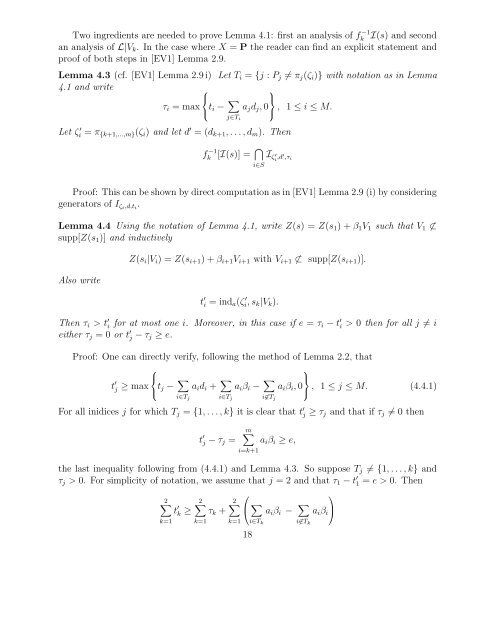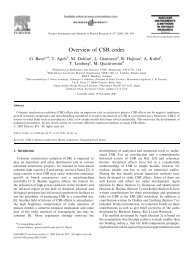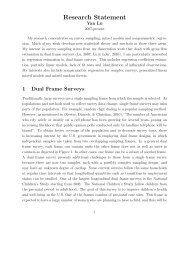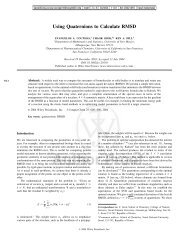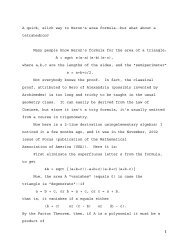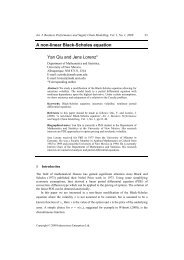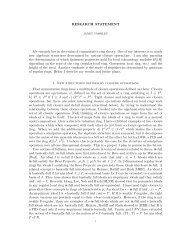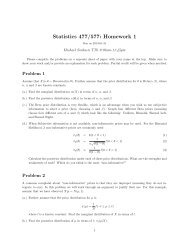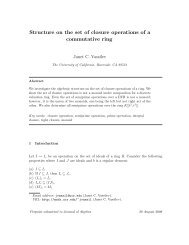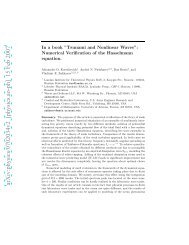Dyson's Lemma and a Theorem of Esnault and Viehweg
Dyson's Lemma and a Theorem of Esnault and Viehweg
Dyson's Lemma and a Theorem of Esnault and Viehweg
You also want an ePaper? Increase the reach of your titles
YUMPU automatically turns print PDFs into web optimized ePapers that Google loves.
Two ingredients are needed to prove <strong>Lemma</strong> 4.1: first an analysis <strong>of</strong> fk−1 I(s) <strong>and</strong> secondan analysis <strong>of</strong> L|V k . In the case where X = P the reader can find an explicit statement <strong>and</strong>pro<strong>of</strong> <strong>of</strong> both steps in [EV1] <strong>Lemma</strong> 2.9.<strong>Lemma</strong> 4.3 (cf. [EV1] <strong>Lemma</strong> 2.9i) Let T i = {j : P j ≠ π j (ζ i )} with notation as in <strong>Lemma</strong>4.1 <strong>and</strong> write⎧⎫⎨τ i = max⎩ t i − ∑ ⎬a j d j , 0⎭ , 1 ≤ i ≤ M.j∈T iLet ζ ′ i = π {k+1,...,m}(ζ i ) <strong>and</strong> let d ′ = (d k+1 , . . .,d m ). Thenf −1k [I(s)] = ⋂I ζ ′i ,d ′ ,τ ii∈SPro<strong>of</strong>: This can be shown by direct computation as in [EV1] <strong>Lemma</strong> 2.9 (i) by consideringgenerators <strong>of</strong> I ζi ,d,t i.<strong>Lemma</strong> 4.4 Using the notation <strong>of</strong> <strong>Lemma</strong> 4.1, write Z(s) = Z(s 1 ) + β 1 V 1 such that V 1 ⊄supp[Z(s 1 )] <strong>and</strong> inductivelyAlso writeZ(s i |V i ) = Z(s i+1 ) + β i+1 V i+1 with V i+1 ⊄ supp[Z(s i+1 )].t ′ i = ind a (ζ ′ i, s k |V k ).Then τ i > t ′ i for at most one i. Moreover, in this case if e = τ i − t ′ i > 0 then for all j ≠ ieither τ j = 0 or t ′ j − τ j ≥ e.Pro<strong>of</strong>: One can directly verify, following the method <strong>of</strong> <strong>Lemma</strong> 2.2, that⎧ ⎫⎨t ′ j ≥ max ⎩ t j − ∑ a i d i + ∑a i β i − ∑ ⎬a i β i , 0 , 1 ≤ j ≤ M. (4.4.1)⎭i∈T j i∈T j i∉T jFor all inidices j for which T j = {1, . . .,k} it is clear that t ′ j ≥ τ j <strong>and</strong> that if τ j ≠ 0 thent ′ j − τ j =m∑i=k+1a i β i ≥ e,the last inequality following from (4.4.1) <strong>and</strong> <strong>Lemma</strong> 4.3. So suppose T j ≠ {1, . . .,k} <strong>and</strong>τ j > 0. For simplicity <strong>of</strong> notation, we assume that j = 2 <strong>and</strong> that τ 1 − t ′ 1 = e > 0. Then⎛⎞2∑ 2∑ 2∑t ′ k ≥ τ k + ⎝ ∑a i β i − ∑a i β i⎠k=1 k=1 k=1 i∈T k i∉T k18


